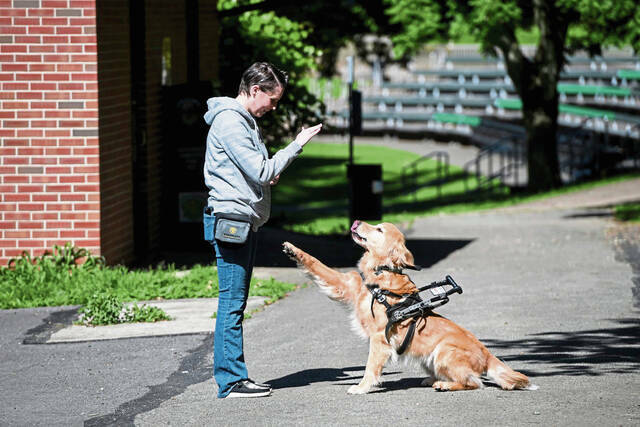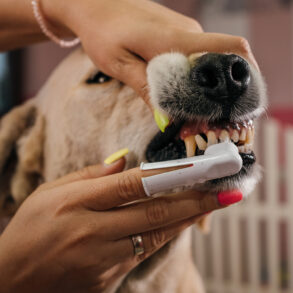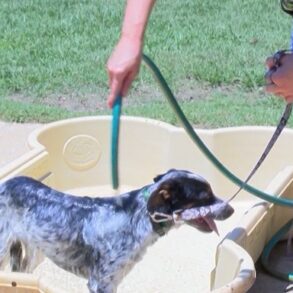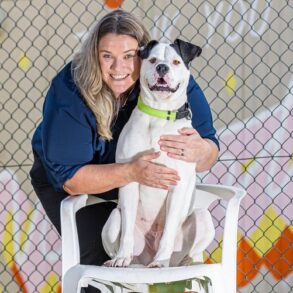
A disabled Army combat medic is on a mission to educate first responders, hospital workers and ambulance personnel to understand that when treating a disabled person with a service dog, it’s critical for the patient to maintain that connection with their four-legged companion.
“It’s important to spread awareness. Do not separate the service dog from the handler unless it is absolutely necessary. The service dogs are trained to lay down in an ambulance or even atop the patient,” said Emily Szekely, 27, of Greensburg, who relies on a service dog.
Szekely suffered a traumatic brain injury and developed a seizure disorder and post-traumatic stress disorder as a result of an incident while in the Army. Szekely, who left the Army in 2018, declined to comment on the circumstances that caused her disability.
Szekely has been training first responders on dealing with service dogs for several years. Earlier this year, she started a business, Protectors and Paws. Szekely is in the process of converting the business into a nonprofit because she said that health care facilities may not have the money for the kind of educational programs she presents.
During a recent training program at the Mutual Aid Ambulance Service in Greensburg, Szekely explained to about 25 first responders that allowing service dogs to accompany their owner when receiving treatment is not only a important for the patient, it’s the law.
Szekely said her service dog has accompanied her on ambulance trips and on a medical helicopter flight to a Pittsburgh hospital when she was suffering a seizure.
“I want to teach them how to properly handle a patient with a service dog,” Szekely said.
Bill Jenkins, medical director for Mutual Aid Ambulance Service, said the type of training Szekely provides their ambulance personnel is important so they better understand the service dog’s role.
“It’s not a distraction to taking care of the patients,” Jenkins said.
That training is important, said Chris Bower of Greensburg, a paramedic and a member of the Westmoreland County Animal Rescue Team, so that the emergency responders know what to do when the patient doesn’t want to be separated from their companion.
And those who are entering the health care field can benefit from the training, said Amy Shearer, director of the nursing program at the University of Pittsburgh-Greensburg. Shearer said she is interested in having Szekely present a program to her nursing students.
“They could encounter them (service dogs),” Shearer said. “It is important for them to know what to do.”
She also is working on making arrangements with Allegheny Health Network to help train their personnel about service dogs.
ADA regulations
Szekely is well-versed in the law and the protections it affords disabled people.
Among those protections is the prohibition against being denied access or service because they can’t produce a certificate or other document to prove their companion is trained as a service dog, Szekely said.
She knows firsthand about the misunderstanding about having a certification because she was told to leave a fitness center in the state of Washington in 2019 because an employee didn’t want her service dog there.
The Americans With Disabilities Act has recognized dogs since 2011 as the only animal that can be designated as a service animal.
The Justice Department defines a service dog as one that is individually trained to do work or perform tasks for the benefit of an individual with a disability.
That includes anyone with a physical, sensory, psychiatric, intellectual, or other mental disability, according to the ADA website.
Under Title II of the ADA, the service dogs like Szekely’s golden retriever are permitted to accompany her in all areas where the public can enter, including public schools, public transportation, health care facilities, voting booths, emergency services and government meetings. A disabled person with a trained service dog must be permitted in a facility, even if there is a policy prohibiting pets, according to the ADA website.
How Simba helps
Szekely explained just how important the service dog’s presence is to her. She doesn’t drive without her service dog and the golden retriever, Simba, with her around the house.
Her dog, with a canine’s keen sense of smell, is able to detect the onset of a seizure by the chemical changes in her body — sometimes 10 or 15 minutes before she feels any symptoms, Szekely said. Medication has been able to reduce the number of seizures she experiences, but not eliminate them, she said.
The dog not only can sense an oncoming seizure, but can summon help when a person is stricken with a seizure, Szekely said.
“If there is a service dog without a handler, follow the dog (to the handler). Service dogs are like life-saving equipment,” she said.
Dog-friendly people are attracted to Szekely’s golden retriever, which presents its own set of problems because service dogs should not be considered pets and approached by dog-friendly people who may want to pet or play with them.
“Distractions can cause a (service) dog to miss a medical alert. It has happened (to me),” Szekely said. “It’s really important not to distract them.”
It is important to understand that the service dogs wearing their vest are working with their owner, Szekely said.
Szekely is in the process of training a new service dog, a standard poodle, to replace Simba, who has developed health issues.
Most of that training is done at home on a daily basis, Szekely said.
Most dogs aren’t capable of being service dogs, having the temperment to be able to do the work, Szekely said.
“Only about 5% of dogs can be service dogs, and only 1% are available to do it,” Szekely said.
And just like humans, the dogs need a break from their work, Szekely said.
“They’re not robots. They need their time off,” Szekely said
But even then, “they will alert to a medical episode when ‘off-duty.’”
Joe Napsha is a TribLive reporter covering Irwin, North Huntingdon and the Norwin School District. He also writes about business issues. He grew up on Neville Island and has worked at the Trib since the early 1980s. He can be reached at jnapsha@triblive.com.
This post was originally published on this site be sure to check out more of their content.







































